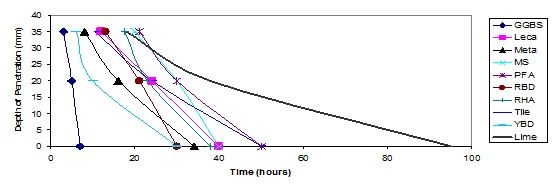Properties and Reactivity of Pozzolans and their Influence on the Quality of Mortars and Concrete
Project coordinator: Associate Prof. Sara Pavia
Funded by: Environmental Protection Agency
Industrial and agricultural waste with pozzolanic properties is used as partial binder replacement in building materials to enhance sustainability and improve the service life of structures. This leads to economic and environmental benefits such as recycling waste, whose disposal threatens the environment, and reducing cement/lime content, with the subsequent drop in energy consumption, non-renewable raw material consumption and CO2 emissions.
 This project studies how pozzolan properties including particle size, specific surface, chemical and mineral composition, amorphousness and water demand affect their reactivity, and consequently the setting and strength of composites. Reactivity was evaluated with chemical, mechanical and mineralogical methods; and the pozzolan properties using XRF, XRD, SEM/EDX, laser diffraction, conductivity and gas adsorption BET. Pozzolans investigated include CKD; GGBS; Leca; PFA; RHA; metakaolin; microsilica; red brick, tile and yellow brick dust. In addition, the properties of mortars with increasing pozzolan content are compared to those of NHL and hydrated lime mortars.
This project studies how pozzolan properties including particle size, specific surface, chemical and mineral composition, amorphousness and water demand affect their reactivity, and consequently the setting and strength of composites. Reactivity was evaluated with chemical, mechanical and mineralogical methods; and the pozzolan properties using XRF, XRD, SEM/EDX, laser diffraction, conductivity and gas adsorption BET. Pozzolans investigated include CKD; GGBS; Leca; PFA; RHA; metakaolin; microsilica; red brick, tile and yellow brick dust. In addition, the properties of mortars with increasing pozzolan content are compared to those of NHL and hydrated lime mortars.
The project has demonstrated that pozzolanic reaction is not as slow as it is generally believed; and that hydrates are clearly present only after 24 hours of curing, forming continuous networks throughout the paste after 14 days. It was also evidenced that pozzolans enhance the modulus of elasticity making lime mortars progressively stiffer however, unlike most building materials, enhanced stiffness and larger elastic regions are not coupled to increased brittleness, and the mortars remain plastic, undergoing significant strain before failure even at high pozzolan contents. The work has also evaluated and established a correlation between techniques that measure reactivity (chemical and physical indices and portlandite consumption) and carried out a comprehensive, comparative study of setting times and water demand for a range of pozzolans.
The results evidenced that all pozzolans reduced the final setting time of lime by at least 40%; and that setting time is highly sensitive to water content: a small (5%) increase in water content significantly delays setting. Other findings are as follows: the pozzolan´s specific surface area governs water demand; amorphousness determines pozzolan reactivity: the most amorphous pozzolans (Metakaolin, GGBS, RHA and MS) are the most active; pozzolans have a lower water demand than hydrated lime therefore replacing lime with pozzolan lowers the water demand of lime mortars and thus their water/binder ratio (except for Metakaolin which has a high water demand on account of its greater fineness and specific surface); metakaolin and GGBS produce pastes of higher strength than any other pozzolan; these are followed by the high-silica pozzolans RHA and MS (68% reduction); and finally the PFA, Leca and the brick dusts with a mechanical index 89% lower than metakaolin. Compressive strength is mainly determined by reactivity (amount of lime combined by the pozzolan) and amorphousness determines reactivity.

